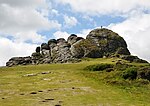Haytor Granite Tramway
4 ft 3 in gauge railways in EnglandDartmoorGraniteHistoric trails and roads in the United KingdomHorse-drawn railways ... and 6 more
Industrial archaeological sites in DevonMining in DevonRail transport in DevonRailway lines closed in 1858Railway lines opened in 1820Tram transport in England

The Haytor Granite Tramway (also called Heytor) was a tramway built to convey granite from Haytor Down, Dartmoor, Devon to the Stover Canal. It was very unusual in that the track was formed of granite sections, shaped to guide the wheels of horse-drawn wagons. It was built in 1820; the granite was in demand in the developing cities of England as masonry to construct public buildings and bridges. In 1850 the quarries employed about 100 men but by 1858 they had closed due to the availability of cheaper Cornish granite.The Haytor rocks and quarries are protected from development and disturbance as a Site of Special Scientific Interest.
Excerpt from the Wikipedia article Haytor Granite Tramway (License: CC BY-SA 3.0, Authors, Images).Haytor Granite Tramway
Haytor Granite Tramway (Disused), Teignbridge Ilsington
Geographical coordinates (GPS) Address Nearby Places Show on map
Geographical coordinates (GPS)
| Latitude | Longitude |
|---|---|
| N 50.586388888889 ° | E -3.7655555555556 ° |
Address
Spoil Heaps
Haytor Granite Tramway (Disused)
TQ13 7TT Teignbridge, Ilsington
England, United Kingdom
Open on Google Maps









